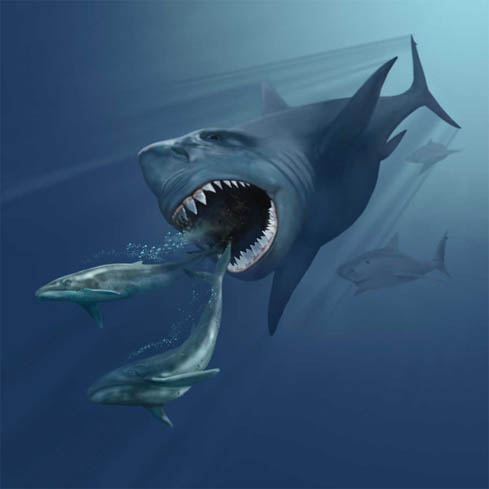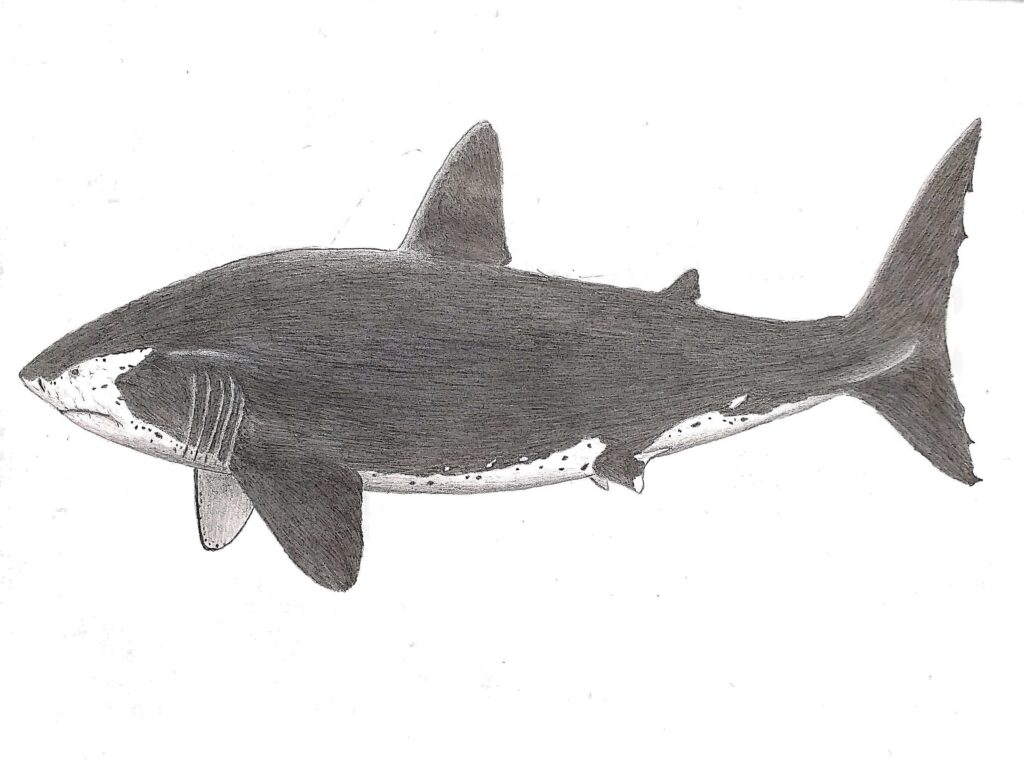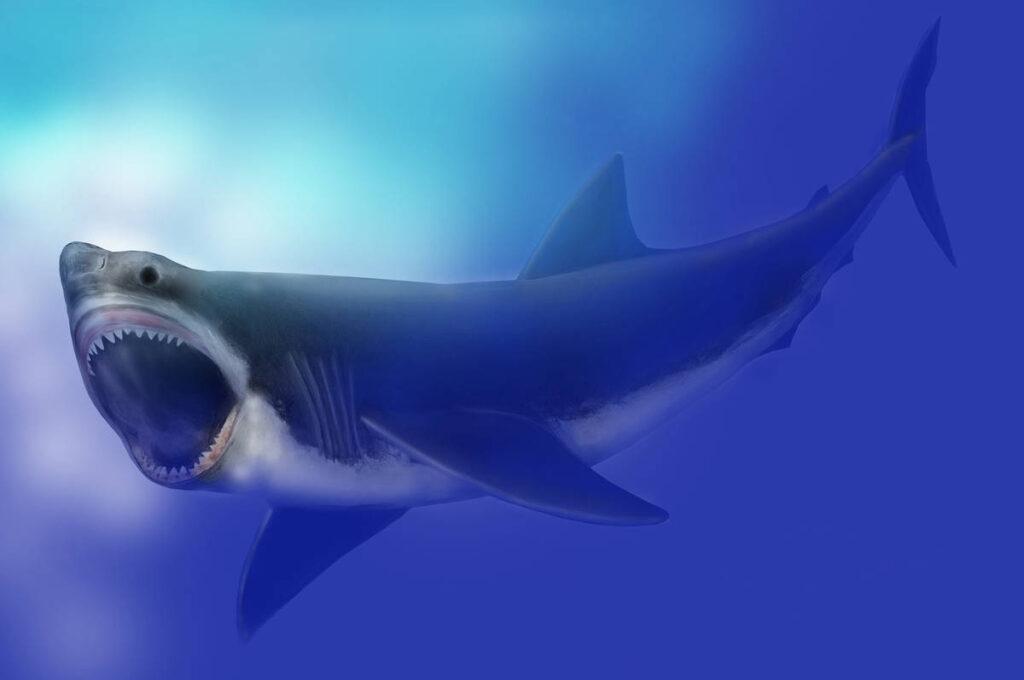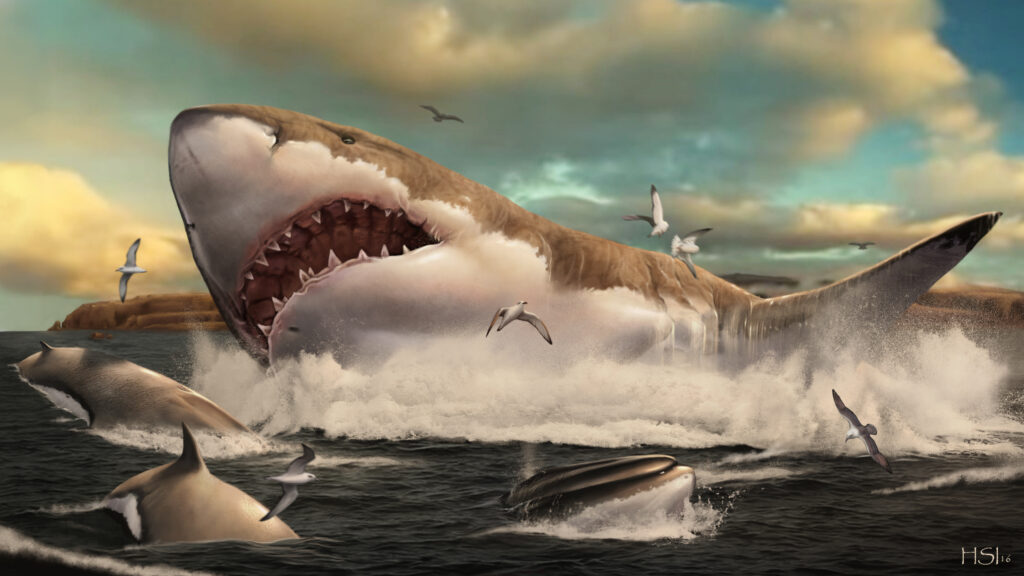When the dinosaurs disappeared approximately 66 million years ago, Earth’s ecosystems underwent a dramatic transformation. In the oceans, new apex predators emerged to fill the ecological void, with one prehistoric shark eventually rising to dominate the marine world. Otodus megalodon, commonly known as the Megalodon, would evolve in the aftermath of this extinction event to become history’s most formidable shark species. This colossal predator’s rise represents a fascinating chapter in our planet’s evolutionary history, demonstrating how life adapts and thrives even after catastrophic events. Let’s explore how this magnificent marine predator came to rule the post-dinosaur oceans.
The End-Cretaceous Extinction Event

Approximately 66 million years ago, a catastrophic asteroid impact in what is now Mexico’s Yucatán Peninsula triggered one of Earth’s most devastating mass extinctions. This cataclysmic event, known as the K-Pg or End-Cretaceous extinction, eliminated approximately 75% of all species on the planet, including all non-avian dinosaurs. The aftermath created ecological vacancies across terrestrial and marine environments, opening evolutionary opportunities for surviving species. In the oceans, the extinction of marine reptiles like mosasaurs and plesiosaurs, which had been dominant predators for millions of years, left predatory niches unfilled. This ecological reset would ultimately set the stage for the rise of new apex predators, including the ancestors of what would become Megalodon.
The Paleogene Recovery Period

Following the mass extinction, Earth entered the Paleogene period, a time of ecological recovery and evolutionary innovation. During this interval, surviving marine species began to diversify and adapt to the changed oceanic conditions. Small shark species that had managed to endure the extinction event found themselves in a world with fewer competitors and predators. The early Paleogene saw a gradual recovery of marine ecosystems, with nutrient cycling and food webs slowly rebuilding to support larger predatory species. This recovery period, lasting millions of years, created the evolutionary foundation for larger shark species to emerge. The ancestors of Megalodon, likely belonging to the Otodus lineage, began their evolutionary journey during this critical time of ecological restructuring.
The Lamniform Shark Advantage

Lamniform sharks, the order that would eventually include Megalodon, possessed several biological advantages that positioned them to thrive in the post-dinosaur world. These sharks featured streamlined bodies, efficient swimming capabilities, and specialized dentition that made them effective predators. Their ability to regulate body temperature (regional endothermy) gave them metabolic advantages over fully cold-blooded competitors, allowing them to hunt in diverse water temperatures and environments. Additionally, lamniforms employed a reproductive strategy involving intrauterine cannibalism, where dominant embryos consume their siblings in the womb, ensuring that only the strongest offspring survive. These biological innovations provided lamniform sharks with competitive edges that would prove crucial as they evolved to fill the vacant apex predator positions in marine ecosystems.
Megalodon’s Evolutionary Origins

Megalodon did not appear immediately after the dinosaurs’ extinction but rather evolved gradually through a series of ancestor species. Paleontologists trace Megalodon’s lineage through the Otodus genus, beginning with smaller species like Otodus obliquus that lived during the Paleocene and Eocene epochs. Over millions of years, these sharks evolved increasingly larger body sizes and serrated teeth—adaptations that would become Megalodon’s hallmarks. The transitional species Otodus angustidens appeared approximately 33 million years ago, showing characteristics intermediate between earlier Otodus species and the later Megalodon. By about 20 million years ago, in the early Miocene epoch, true Megalodon had emerged as a distinct species. This evolutionary process, spanning approximately 45 million years after the dinosaurs’ extinction, demonstrates the gradual nature of evolutionary adaptation rather than an immediate replacement.
The Perfect Predatory Design

Megalodon evolved a body plan and hunting strategy perfectly suited for dominating Miocene oceans. Growing to estimated lengths of 50-60 feet, it possessed enormous triangular teeth reaching over seven inches in height with fine serrations for efficiently cutting through flesh and bone. Its massive jaws generated bite forces estimated between 108,000 and 182,000 newtons, far exceeding those of any other known predator, including the modern great white shark. Megalodon’s body featured a robust, spindle-shaped design that balanced speed and power, while its strong cartilaginous skeleton supported its enormous mass. The shark’s broad pectoral fins provided exceptional maneuverability despite its size, allowing it to pursue fast-moving prey. This combination of size, strength, and specialized adaptations made Megalodon the most formidable marine predator of its time, capable of hunting even the largest whale species.
Megalodon’s Global Dominance

Fossil evidence indicates Megalodon achieved a nearly global distribution, establishing itself as the ocean’s supreme predator across tropical and temperate waters worldwide. Megalodon teeth have been discovered on every continent except Antarctica, demonstrating the species’ extensive range and adaptability to various marine environments. This cosmopolitan distribution stands in stark contrast to many modern apex predators, which often occupy more limited geographical ranges. Megalodon thrived in coastal environments but likely ventured into open ocean waters as well, following migratory prey species. Its widespread presence across different oceanic regions suggests Megalodon could adapt to varying water temperatures and ecological conditions. This global dominance, unmatched by any single marine predator today, illustrates how thoroughly Megalodon filled the ecological void left by extinct Mesozoic marine reptiles.
The Apex Predator’s Diet

Megalodon’s massive size required substantial caloric intake, driving the shark to target the largest prey available in its ecosystem. Paleontological evidence, including fossil whale bones bearing distinctive Megalodon bite marks, confirms that these sharks preyed heavily on prehistoric whales, including ancestors of today’s baleen and toothed whales. Studies of these bite marks reveal strategic hunting tactics, with Megalodon often targeting the nutrient-rich organs and energy-dense blubber by attacking the chest and abdominal regions of its prey. Beyond whales, Megalodon’s diet likely included large sea turtles, seals, sirenians (relatives of modern manatees), and other sharks. Some research suggests adult Megalodons required over 2,500 pounds of food daily to sustain their massive bodies. This voracious appetite made Megalodon a primary controlling factor in marine ecosystem dynamics, similar to how large carnivorous dinosaurs had shaped terrestrial ecosystems before their extinction.
Megalodon’s Hunting Strategies

Analyses of fossilized bite marks and Megalodon’s anatomy have allowed scientists to reconstruct its likely hunting behaviors, revealing a sophisticated predator that employed strategic approaches rather than merely relying on size. When hunting large whales, Megalodon likely attacked from below, targeting the flippers and tail flukes first to immobilize its prey before delivering fatal bites to the vital organs. This methodical approach minimized the risk of injury while hunting dangerous prey many times heavier than itself. For smaller prey, Megalodon could employ burst swimming to ambush victims with surprising speed despite its enormous size. Evidence suggests that juvenile Megalodons inhabited separate nursery areas and hunted smaller prey until reaching sizes capable of tackling adult whales, demonstrating ontogenetic (developmental) shifts in hunting strategy. This combination of power, precision, and tactical sophistication made Megalodon an extraordinarily effective predator that could exploit virtually any prey species in its environment.
Reshaping Marine Ecosystems

Megalodon’s dominance reshaped marine environments through cascading ecological effects that influenced countless other species. As the ocean’s apex predator, Megalodon controlled populations of large marine mammals and other mesopredators, preventing any single prey species from dominating ecosystems. This predatory pressure likely drove evolutionary adaptations in prey species, including the development of faster swimming capabilities, different migratory patterns, and potentially even the large brain sizes observed in cetaceans. Some paleobiologists theorize that the presence of Megalodon may have influenced the habitat preferences of ancient whales, potentially accelerating their evolution toward deeper oceanic environments where the massive shark couldn’t as easily hunt them. Additionally, Megalodon’s feeding activity would have redistributed nutrients through the water column when it dismembered prey, indirectly benefiting scavengers and filter-feeding organisms. Through these varied mechanisms, Megalodon functioned as a keystone species that maintained balance within marine ecosystems across its 20-million-year reign.
Coexistence with Early Great Whites

During the late Miocene epoch, approximately 5-7 million years ago, Megalodon shared the oceans with a newly evolved predator that would ultimately outlast it—the great white shark (Carcharodon carcharias). Though smaller than Megalodon, the great white evolved specialized adaptations that allowed it to exploit different ecological niches, reducing direct competition between the species. While Megalodon primarily targeted large marine mammals, early great whites likely specialized in smaller prey items and scavenging behaviors. Fossil evidence suggests the two species maintained geographical separation, with great whites often preferring cooler waters while Megalodon dominated warmer regions. This ecological partitioning allowed both apex predators to coexist for several million years. However, as climate conditions changed and Megalodon’s preferred prey evolved, the great white’s greater adaptability and lower caloric requirements would ultimately prove advantageous for long-term survival.
Climate Change and Megalodon’s Decline

After thriving for approximately 20 million years, Megalodon faced mounting environmental challenges during the Pliocene epoch. Global cooling trends beginning around 5 million years ago triggered substantial changes in ocean circulation patterns and temperatures. This cooling led to the formation of polar ice caps and declining sea levels, which reduced coastal shelf habitats that had served as Megalodon’s primary hunting grounds. The changing conditions altered the distribution and migration patterns of Megalodon’s preferred prey species, particularly large whales that began favoring polar feeding grounds beyond Megalodon’s temperature tolerance. Isotopic analyses of Megalodon teeth from this period suggest the species may have experienced increasing resource stress as its prey base shifted. These environmental pressures gradually restricted Megalodon’s range and abundance, demonstrating how even Earth’s most formidable predators remain vulnerable to large-scale climate fluctuations.
The Final Extinction

Megalodon ultimately vanished from Earth’s oceans approximately 3.6-2.6 million years ago, with its extinction coinciding with major changes in marine mammal evolution and distribution. As global cooling intensified, many whale species evolved to grow larger and swim faster, potentially outpacing Megalodon’s hunting capabilities. Simultaneously, these whales increasingly migrated to polar feeding grounds where Megalodon could not follow due to its apparent preference for warmer waters. The combined pressures of habitat loss, prey redistribution, and competition with smaller, more adaptable shark species like the great white created a perfect storm of extinction pressures. Megalodon’s massive size, once its greatest advantage, became a liability as it required enormous caloric intake that increasingly couldn’t be sustained in the changing oceans. Despite having successfully ruled the post-dinosaur oceans for millions of years, Megalodon couldn’t adapt quickly enough to overcome these cumulative challenges, highlighting the impermanence of even the most dominant species.
Megalodon’s Evolutionary Legacy

Though extinct for millions of years, Megalodon’s evolutionary importance extends beyond its time as Earth’s apex marine predator. Its reign represents a crucial chapter in the post-dinosaur recovery of marine ecosystems, demonstrating how life adapts to fill ecological vacuums after extinction events. Modern sharks, particularly great whites and other lamniform species, evolved many parallel adaptations independently of Megalodon, showcasing the phenomenon of convergent evolution toward similar predatory strategies. Megalodon’s extinction also played a significant role in shaping modern marine mammal populations, potentially allowing for the diversification and size increases observed in modern whales once they were freed from this predatory pressure. Perhaps most importantly, studying Megalodon’s rise and fall provides valuable insights into how large predators respond to climate change—lessons with relevance to conservation efforts for today’s threatened shark species. In this way, Megalodon continues to influence our understanding of marine ecology, evolution, and climate relationships long after its disappearance.
Conclusion

The story of Megalodon represents one of nature’s most remarkable evolutionary successes following a planetary catastrophe. Rising from the ashes of the dinosaur extinction, this colossal shark evolved to dominate Earth’s oceans for over 20 million years, longer than humans have existed. Its reign demonstrates the resilience of life and the dynamic nature of ecological succession. While Megalodon ultimately could not survive Earth’s changing climate, its evolutionary journey offers profound insights into how ecosystems recover from mass extinctions and how apex predators shape the natural world. As modern oceans face unprecedented human-driven challenges, the rise and fall of Megalodon reminds us that even the mightiest species remain vulnerable to environmental change—a lesson perhaps more relevant today than ever before.




